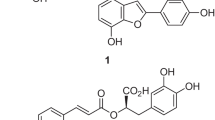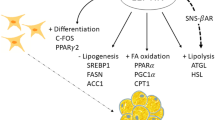Abstract
Metabolic syndrome (MBS), a cluster of metabolic abnormalities and visceral fat accumulation, increases cardiovascular risks in postmenopausal women. In addition to visceral fat, perivascular adipose tissue has been recently found to play an important role in vascular pathophysiology. Hence, the present study investigates the effects of estrogen on both intra-abdominal fat (visceral fat) and periaortic fat (perivascular fat) accumulation as well as hypoxia in ovariectomized female rats. Female rats were divided into sham operation, ovariectomy and ovariectomy with 17β-estradiol supplementation groups. Twelve weeks later, we found that estrogen improved MBS via reducing body weight gain, the weight of periaortic and intra-abdominal fat, hepatic triglyceride, and total serum cholesterol levels. Estrogen also increased insulin sensitivity through restoring glucose and serum leptin levels. For periaortic fat, western blot showed estrogen inhibited hypoxia by reducing the levels of VEGF and HIF-1α, which is consistent with the results from immunohistochemical staining. The correlation analysis indicated that perivascular fat had a positive correlation with body weight, intra-abdominal fat or serum total cholesterol, but a negative correlation with insulin sensitivity index. For intra-abdominal fat, real-time fluorescent RT-PCR showed estrogen improved fat dysfunction via reducing the levels of relative leptin, MCP-1 but increasing adiponectin mRNA. Estrogen reduced the levels of VEGF and HIF-1α to inhibit hypoxia but restored the levels of PPARγ and Srebp-1c, which are important for lipid capacity function of intra-abdominal fat. These results demonstrated estrogen improved MBS through down-regulating VEGF and HIF-1α to inhibit hypoxia of periaortic and intra-abdominal fat in ovariectomized female rats.






Similar content being viewed by others
References
Cagnacci A, Cannoletta M, Caretto S, Zanin R, Xholli A, Volpe A (2011) Increased cortisol level: a possible link between climacteric symptoms and cardiovascular risk factors. Menopause 18:273–278. doi:10.1097/gme.0b013e3181f31947
Gungor F, Kalelioglu I, Turfanda A (2009) Vascular effects of estrogen and progestins and risk of coronary artery disease: importance of timing of estrogen treatment. Angiology 60:308–317. doi:10.1177/0003319708318377
Lobo RA (2007) Postmenopausal hormones and coronary artery disease: potential benefits and risks. Climacteric 10:21–26. doi:10.1080/13697130701578631
Innes KE, Selfe TK, Taylor AG (2008) Menopause, the metabolic syndrome, and mind-body therapies. Menopause 15:1005–1013. doi:10.1097/01.gme.0b013e318166904e
Okada S, Suzuki A, Watanabe H, Watanabe T, Aizawa Y (2010) Reversal rate of clustering of cardiovascular disease risk factors of metabolic syndrome in the general population: the niigata preventive medicine study. J Obes 2010:623593. doi:10.1155/2010/623593
Janssen I, Powell LH, Crawford S, Lasley B, Sutton-Tyrrell K (2008) Menopause and the metabolic syndrome: the study of women’s health across the nation. Arch Intern Med 168:1568–1575. doi:10.1001/archinte.168.14.1568
Cho GJ, Lee JH, Park HT, Shin JH, Hong SC, Kim T, Hur JY, Lee KW, Park YK, Kim SH (2008) Postmenopausal status according to years since menopause as an independent risk factor for the metabolic syndrome. Menopause 15:524–529. doi:10.1097/gme.0b013e3181559860
Gao YJ (2007) Dual modulation of vascular function by perivascular adipose tissue and its potential correlation with adiposity/lipoatrophy-related vascular dysfunction. Curr Pharm Des 13:2185–2192
Gollasch M, Dubrovska G (2004) Paracrine role for periadventitial adipose tissue in the regulation of arterial tone. Trends Pharmacol Sci 25:647–653. doi:10.1016/j.tips.2004.10.005
Robinson ST, Taylor WR (2009) Beyond the adventitia: exploring the outer limits of the blood vessel wall. Circ Res 104:416–418. doi:10.1161/CIRCRESAHA.109.194225
Stern N, Marcus Y (2006) Perivascular fat: innocent bystander or active player in vascular disease? J Cardiometab Syndr 1:115–120
Chatterjee TK, Stoll LL, Denning GM, Harrelson A, Blomkalns AL, Idelman G, Rothenberg FG, Neltner B, Romig-Martin SA, Dickson EW, Rudich S, Weintraub NL (2009) Proinflammatory phenotype of perivascular adipocytes: influence of high-fat feeding. Circ Res 104:541–549. doi:10.1161/CIRCRESAHA.108.182998
Reifenberger MS, Turk JR, Newcomer SC, Booth FW, Laughlin MH (2007) Perivascular fat alters reactivity of coronary artery: effects of diet and exercise. Med Sci Sports Exerc 39:2125–2134. doi:10.1249/mss.0b013e318156e9df
Takaoka M, Nagata D, Kihara S, Shimomura I, Kimura Y, Tabata Y, Saito Y, Nagai R, Sata M (2009) Periadventitial adipose tissue plays a critical role in vascular remodeling. Circ Res 105:906–911. doi:10.1161/CIRCRESAHA.109.199653
Greenstein AS, Khavandi K, Withers SB, Sonoyama K, Clancy O, Jeziorska M, Laing I, Yates AP, Pemberton PW, Malik RA, Heagerty AM (2009) Local inflammation and hypoxia abolish the protective anticontractile properties of perivascular fat in obese patients. Circulation 119:1661–1670. doi:10.1161/CIRCULATIONAHA.108.821181
Folch J, Lees M, Sloane Stanley GH (1957) A simple method for the isolation and purification of total lipides from animal tissues. J Biol Chem 226:497–509
Rocha S (2007) Gene regulation under low oxygen: holding your breath for transcription. Trends Biochem Sci 32:389–397. doi:10.1016/j.tibs.2007.06.005
Pighon A, Barsalani R, Yasari S, Prud’homme D, Lavoie JM (2009) Does exercise training prior to ovariectomy protect against liver and adipocyte fat accumulation in rats? Climacteric 13:238–248. doi:10.3109/13697130903009203
Lakka HM, Laaksonen DE, Lakka TA, Niskanen LK, Kumpusalo E, Tuomilehto J, Salonen JT (2002) The metabolic syndrome and total and cardiovascular disease mortality in middle-aged men. JAMA 288:2709–2716
Schlett CL, Massaro JM, Lehman SJ, Bamberg F, O’Donnell CJ, Fox CS, Hoffmann U (2009) Novel measurements of periaortic adipose tissue in comparison to anthropometric measures of obesity, and abdominal adipose tissue. Int J Obes (Lond) 33:226–232. doi:10.1038/ijo.2008.267
Lohn M, Dubrovska G, Lauterbach B, Luft FC, Gollasch M, Sharma AM (2002) Periadventitial fat releases a vascular relaxing factor. Faseb J 16:1057–1063. doi:10.1096/fj.02-0024com
Malinowski M, Deja MA, Golba KS, Roleder T, Biernat J, Wos S (2008) Perivascular tissue of internal thoracic artery releases potent nitric oxide and prostacyclin-independent anticontractile factor. Eur J Cardiothorac Surg 33:225–231. doi:10.1016/j.ejcts.2007.11.007
Verlohren S, Dubrovska G, Tsang SY, Essin K, Luft FC, Huang Y, Gollasch M (2004) Visceral periadventitial adipose tissue regulates arterial tone of mesenteric arteries. Hypertension 44:271–276. doi:10.1161/01.HYP.0000140058.28994.ec
Soltis EE, Cassis LA (1991) Influence of perivascular adipose tissue on rat aortic smooth muscle responsiveness. Clin Exp Hypertens A 13:277–296
Gao YJ, Takemori K, Su LY, An WS, Lu C, Sharma AM, Lee RM (2006) Perivascular adipose tissue promotes vasoconstriction: the role of superoxide anion. Cardiovasc Res 71:363–373. doi:10.1016/j.cardiores.2006.03.013
Wang P, Xu TY, Guan YF, Su DF, Fan GR, Miao CY (2009) Perivascular adipose tissue-derived visfatin is a vascular smooth muscle cell growth factor: role of nicotinamide mononucleotide. Cardiovasc Res 81:370–380. doi:10.1093/cvr/cvn288
Barandier C, Montani JP, Yang Z (2005) Mature adipocytes and perivascular adipose tissue stimulate vascular smooth muscle cell proliferation: effects of aging and obesity. Am J Physiol Heart Circ Physiol 289:H1807–H1813. doi:10.1152/ajpheart.01259.2004
Fésüs G, Dubrovska G, Gorzelniak K, Kluge R, Huang Y, Luft FC, Gollasch M (2007) Adiponectin is a novel humoral vasodilator. Cardiovasc Res 75:719–727. doi:10.1016/j.cardiores.2007.05.025
Gálvez B, de Castro J, Herold D, Dubrovska G, Arribas S, González MC, Aranguez I, Luft FC, Ramos MP, Gollasch M, Fernández Alfonso MS (2006) Perivascular adipose tissue and mesenteric vascular function in spontaneously hypertensive rats. Arterioscler Thromb Vasc Biol 26:1297–1302. doi:10.1161/01.ATV.0000220381.40739.dd
Zeng ZH, Zhang ZH, Luo BH, He WK, Liang LY, He CC, Su CJ (2009) The functional changes of the perivascular adipose tissue in spontaneously hypertensive rats and the effects of atorvastatin therapy. Clin Exp Hypertens 31:355–363
Ye J (2009) Emerging role of adipose tissue hypoxia in obesity and insulin resistance. Int J Obes (Lond) 33:54–66. doi:10.1038/ijo.2008.229
Trayhurn P, Wang B, Wood IS (2008) Hypoxia in adipose tissue: a basis for the dysregulation of tissue function in obesity? Br J Nutr 100:227–235. doi:10.1017/S0007114508971282
Semenza GL (2000) Surviving ischemia: adaptive responses mediated by hypoxia-inducible factor 1. J Clin Invest 106:809–812. doi:10.1172/JCI11223
Halberg N, Khan T, Trujillo ME, Wernstedt-Asterholm I, Attie AD, Sherwani S, Wang ZV, Landskroner-Eiger S, Dineen S, Magalang UJ, Brekken RA, Scherer PE (2009) Hypoxia-inducible factor 1alpha induces fibrosis and insulin resistance in white adipose tissue. Mol Cell Biol 29:4467–4483. doi:10.1128/MCB.00192-09
Jarvilehto M, Tuohimaa P (2009) Vasa vasorum hypoxia: initiation of atherosclerosis. Med Hypotheses 73:40–41. doi:10.1016/j.mehy.2008.11.046
Drinane M, Mollmark J, Zagorchev L, Moodie K, Sun B, Hall A, Shipman S, Morganelli P, Simons M, Mulligan-Kehoe MJ (2009) The antiangiogenic activity of rPAI-1(23) inhibits vasa vasorum and growth of atherosclerotic plaque. Circ Res 104:337–345. doi:10.1161/CIRCRESAHA.108.184622
Gössl M, Herrmann J, Tang H, Versari D, Galili O, Mannheim D, Rajkumar SV, Lerman LO, Lerman A (2009) Prevention of vasa vasorum neovascularization attenuates early neointima formation in experimental hypercholesterolemia. Basic Res Cardiol 104:695–706. doi:10.1007/s00395-009-0036-0
Rachon D, Vortherms T, Seidlova-Wuttke D, Wuttke W (2007) Effects of dietary equol on body weight gain, intra-abdominal fat accumulation, plasma lipids, and glucose tolerance in ovariectomized Sprague-Dawley rats. Menopause 14:925–932. doi:10.1097/GME.0b013e31802d979b
Semenza GL (2003) Targeting HIF-1 for cancer therapy. Nat Rev Cance 3:721–732. doi:10.1038/nrc1187
Xiang ZL, Zeng ZC, Fan J, Tang ZY, He J, Zeng HY, Chang JY (2011) The expression of HIF-1α in primary hepatocellular carcinoma and its correlation with radiotherapy response and clinical outcome. Mol Biol Rep [Epub ahead of print]. doi: 10.1007/s11033-011-0949-1
Yanyan C, Guoxian Q, Yang G, Leting W (2008) Mechanism of hypoxia-induced factor 1alpha expression in endothelial cells of the human umbilical vein and its induction of apoptosis. Mol Biol Rep 35:285–290. doi:10.1007/s11033-007-9083-5
Xiang Q, Lin G, Xu J, Zheng S, Chen S, Zhou K, Wang T (2010) The role of caveolin1 and sprouty1 in genistein’s regulation of vascular smooth muscle cell and endothelial cell proliferation. Eur J Pharmacol 648:153–161. doi:10.1016/j.ejphar.2010.08.043
Acknowledgments
The authors declared no conflict of interest. This work is supported by National Natural Science Foundation of P. R. China (No: 30700282) and Guangdong Natural Science Foundation (No: 06021361). We also gratefully acknowledge the professional assistance of Dr. Panwei Mu and Prof. Lin Li in the third affiliated hospital of Sun Yat-Sen University. We acknowledge Prof. Chiu Shuen Hui (Indiana University-Purdue University Indianapolis) for reading and correcting the manuscript.
Author information
Authors and Affiliations
Corresponding author
Additional information
JinWen Xu, QiuLing Xiang contributed equal to this work.
Electronic supplementary material
Below is the link to the electronic supplementary material.
Rights and permissions
About this article
Cite this article
Xu, J., Xiang, Q., Lin, G. et al. Estrogen improved metabolic syndrome through down-regulation of VEGF and HIF-1α to inhibit hypoxia of periaortic and intra-abdominal fat in ovariectomized female rats. Mol Biol Rep 39, 8177–8185 (2012). https://doi.org/10.1007/s11033-012-1665-1
Received:
Accepted:
Published:
Issue Date:
DOI: https://doi.org/10.1007/s11033-012-1665-1




